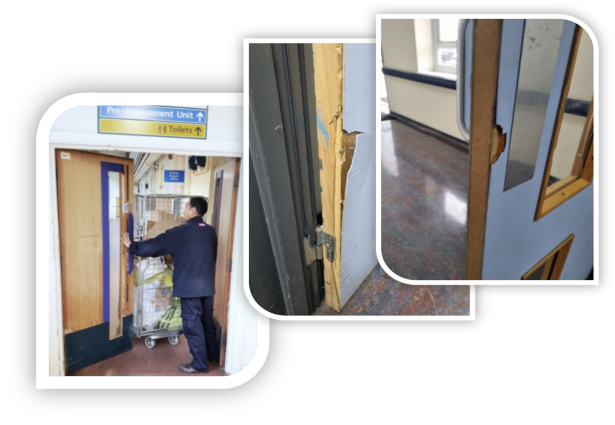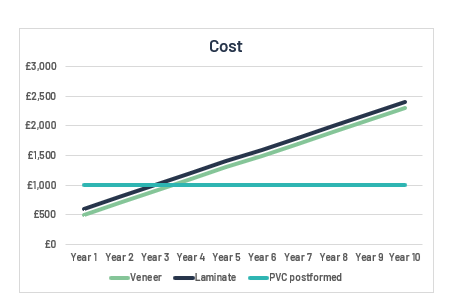Caring for the bottom line
“Incorporating PVC post-formed door set provides a product that is easy to keep clinically clean and is fit for purpose for years to come.” David Whitestone, Director, Floyd Slaski Architects Limited
When you are shopping around for doors, the reasons for choosing one door type over another will often crystallise around price. But it is not the only thing we should consider.
Whilst one door set may cost £1,500 and the other costs £750, which one do you choose? If you are only interested at looking at the initial cost, then the choice is obvious, you will specify the one with the lower cost. After all, both are fire doors, both look great, at least from a distance and both are hygienic and easy to clean. Easy decision?
However, this scenario continues into the site install and initial use. Door manufacturers are working hard to make their products easier to install, with greater ‘off site’ construction methods allowing for the increasing range of installs, modular, new build, and refurbishment. In each case, the doors will, assuming a competent installer, be fitted with ease and cover a range of compliance measures designed to keep the occupants safe.
Taking time to look beyond the initial aesthetics and cost, reveals a different story, one which could take you down a darker path towards a wide range of issues not considered at the point of purchase.
Looking beyond compliance
In a recent survey carried out by Fire Door Inspection Scheme noted that 75% of fire doors in public buildings were non-compliant. This is a horrifying number when we consider the tragedies of fires in public buildings.
Compliance is not simply a matter of installing to correct tolerances although this is a key starting point. Beyond this there are a multitude of other factors to consider; maintenance, damage, general wear, and tear and yes, aesthetics - as doors are part of the furniture which contributes to an environment that is conducive to patient wellbeing and recovery.
The material that a door is made from can have a significant impact on the life span of your door. When comparing Laminate with PVC post-formed doors there are several points to consider.
First, let us consider Laminate.
Laminate
- Cheaper initial cost
- Attractive appearance
- Hygienically sound
- Available in a range of specifications
Given that these requirements address the needs of every healthcare department, why would you consider a more expensive alternative? We have come up with some valid reasons for you to consider.
PVC post-formed
- Lifespan cost – a PVC door will typically last four times that of a laminate door.
- ‘Iron fist, velvet glove’ – a PVC door will withstand the heavy traffic of a busy hospital
without degrading the way a timber door set will. - Hygiene – the war against MRSA and other viruses and germs. PVC doors are tough enough
to withstand over two hundred of the harshest hospital cleaning products. - A huge array of colours and contrasts. From the ‘Hotel spec’ woodgrains to the vibrant
contrast of a children’s ward, PVC can cover it all, and all to the same degree of compliance.
But what about durability?
The initial lower cost usually leads to poor durability, and in a high-traffic, healthcare environment, doors are subject to damage from numerous activities such as porter trolleys, transportation of beds through corridors and, even though edge protection and half-height PVC kickplates will significantly increase the durability of the door and therefore it’s lifetime, the edge protectors and kickplates will, like a car bumper, get damaged and once damaged, will need replacing.

Long-term maintenance
Making maintenance easy should be at the forefront of a manufacturer’s design but this is often not the case. The minute a Laminate door set is chipped, or cracked, its fire compliance is gone. The moment the surface is compromised, its hygienic compliance is gone. There are two scenarios from this juncture.
- Firstly, you have a competent facilities team who will replace the door, at cost, repeatedly as it fails. However, with the cost to replace the doors, also comes the labour cost to install it.
- Secondly, you may have a less competent or stretched team, who do not have the time to maintain or undertake the necessary checks. Consequently, door sets become non-compliant and unhygienic, and each issue comes with its own set of dangers.
Now we consider what the same scenario would have on a PVC door. PVC absorbs impact and does not chip, crack or break up like Laminate does. The complete edge-to-edge protection does away with easily damaged and exposed timber lipping’s and adds to the overall strength of the door and long-term cost saving on replacements.
Whilst all doors require maintenance checks, PVC doorsets will not require the same degree of labour to repeatedly replace, and their hardwearing surfaces will continue to provide hygienic protection with a regular cleaning programme in place far longer than a standard Laminate door.
Cost vs value
If we look beyond the initial purchase price and consider the whole lifetime of the door set, then the cost comparison between a Laminate and PVC door looks considerably different.
For example:
Scenario A: Most timber-lipped doors, complete with edge protection and half-height PVC kickplates cost around £500 to £600 and in a high-traffic, healthcare environment, the edge protectors and kickplates may need to be replaced every 6-12 months and the complete doorset may also require replacement during the 10-year period.
Scenario B: PVC post-formed doorsets cost around £1,000, however, they will not require replacement during the 10-year period. (Most PVC Postformed doors will last far longer than this – but we wanted to be conservative).

Note: Lifetime costs calculated based on the concept of value engineering as published in ‘The Green Book’. Calculations are based on a time horizon of 10 years, taking into consideration initial purchase, repairs, and physical maintenance.
Summary
Over a ten-year lifespan, a standard Laminate/Veneer doorset will typically require bi-annual maintenance; in comparison, a PVC post-formed door would usually require no maintenance. The result is a significant overall cost saving, often equating to more than the initial cost of the doorset, without considering the hidden costs and difficulties in accessing live hospital areas and also the periods that the doorset will have been non-compliant in the run-up to the maintenance taking place.
When we consider the lifespan, both monetarily and reputationally, the suitability of PVC doorsets comes to the fore. Remaining attractive and compliant as their Laminate counterparts fall by the wayside time and time again.
To find out more about all of our products, please contact the team today.

